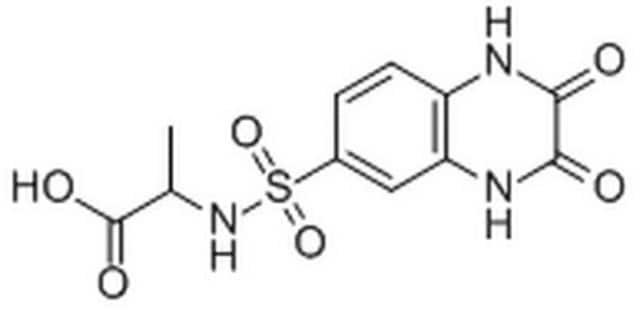189400
Aurintricarboxylic Acid
A cell-permeable polyanionic, polyaromatic compound used as a powerful inhibitor of cellular processes that are dependent on the formation of protein-nucleic acid complexes.
Synonym(s):
Aurintricarboxylic Acid, ATA
About This Item
Recommended Products
Quality Level
Assay
≥85% (titration)
form
solid
manufacturer/tradename
Calbiochem®
storage condition
OK to freeze
color
red
solubility
0.1 M NaOH: 35 mg/mL
shipped in
ambient
storage temp.
10-30°C
InChI
1S/C22H16O9.3H3N/c23-16-4-1-10(7-13(16)20(26)27)19(11-2-5-17(24)14(8-11)21(28)29)12-3-6-18(25)15(9-12)22(30)31;;;/h1-10,19,24-25H,(H,26,27)(H,28,29)(H,30,31);3*1H3
InChI key
UDPQMNAHKKTHHI-UHFFFAOYSA-N
General description
Biochem/physiol Actions
DNA topoisomerase 2
Warning
Reconstitution
Other Notes
Benchokroun, Y., et al. 1995. Biochem. Pharmacol.49, 305.
Okada, N., and Koizumi, S. 1995. J. Biol. Chem.270, 16464.
Posner, A., et al. 1995. Biochem. Mol. Biol. Int. 36, 291.
Catchpoole, D.R., et al. 1994. Anticancer Res. 14, 853.
Csernansky, C.A., et al. 1994. J. Neurosci. Res. 38, 101.
Gagliardi, A.R., and Collins, D.C. 1994. Anticancer Res. 14, 475.
Gonzalez, R.G., et al. 1980. Biochemistry19, 4299.
Legal Information
Storage Class Code
11 - Combustible Solids
WGK
WGK 3
Flash Point(F)
Not applicable
Flash Point(C)
Not applicable
Certificates of Analysis (COA)
Search for Certificates of Analysis (COA) by entering the products Lot/Batch Number. Lot and Batch Numbers can be found on a product’s label following the words ‘Lot’ or ‘Batch’.
Already Own This Product?
Find documentation for the products that you have recently purchased in the Document Library.
Our team of scientists has experience in all areas of research including Life Science, Material Science, Chemical Synthesis, Chromatography, Analytical and many others.
Contact Technical Service







